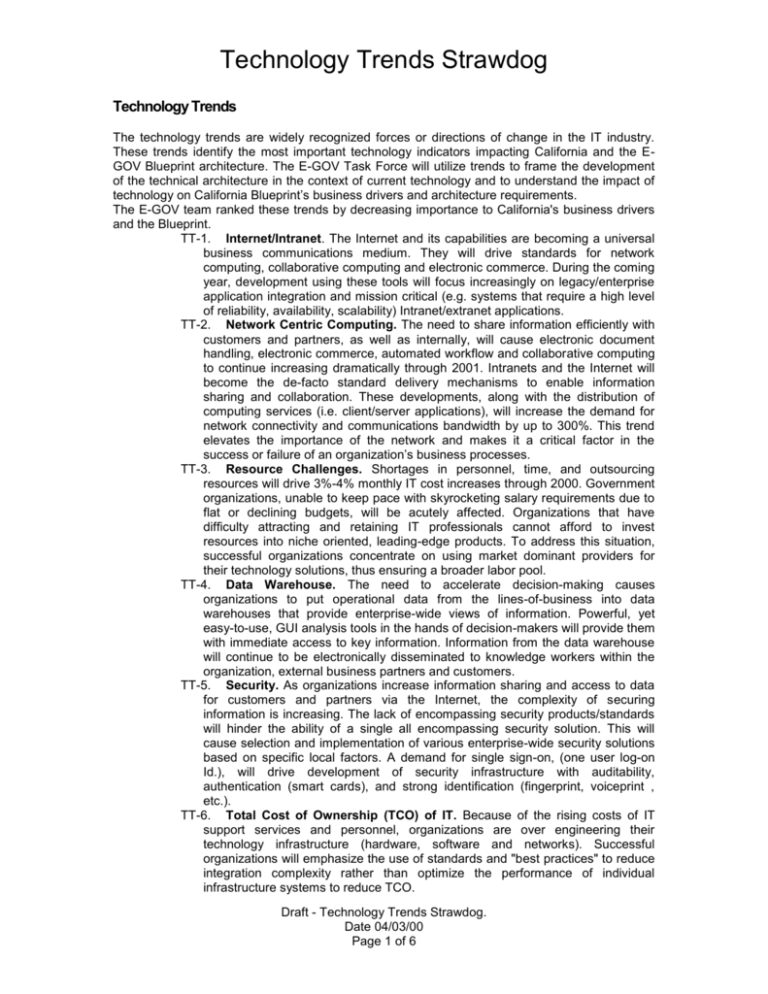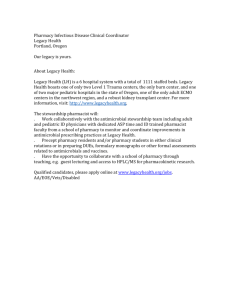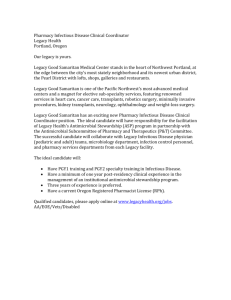Technical Trends SD
advertisement

Technology Trends Strawdog Technology Trends The technology trends are widely recognized forces or directions of change in the IT industry. These trends identify the most important technology indicators impacting California and the EGOV Blueprint architecture. The E-GOV Task Force will utilize trends to frame the development of the technical architecture in the context of current technology and to understand the impact of technology on California Blueprint’s business drivers and architecture requirements. The E-GOV team ranked these trends by decreasing importance to California's business drivers and the Blueprint. TT-1. Internet/Intranet. The Internet and its capabilities are becoming a universal business communications medium. They will drive standards for network computing, collaborative computing and electronic commerce. During the coming year, development using these tools will focus increasingly on legacy/enterprise application integration and mission critical (e.g. systems that require a high level of reliability, availability, scalability) Intranet/extranet applications. TT-2. Network Centric Computing. The need to share information efficiently with customers and partners, as well as internally, will cause electronic document handling, electronic commerce, automated workflow and collaborative computing to continue increasing dramatically through 2001. Intranets and the Internet will become the de-facto standard delivery mechanisms to enable information sharing and collaboration. These developments, along with the distribution of computing services (i.e. client/server applications), will increase the demand for network connectivity and communications bandwidth by up to 300%. This trend elevates the importance of the network and makes it a critical factor in the success or failure of an organization’s business processes. TT-3. Resource Challenges. Shortages in personnel, time, and outsourcing resources will drive 3%-4% monthly IT cost increases through 2000. Government organizations, unable to keep pace with skyrocketing salary requirements due to flat or declining budgets, will be acutely affected. Organizations that have difficulty attracting and retaining IT professionals cannot afford to invest resources into niche oriented, leading-edge products. To address this situation, successful organizations concentrate on using market dominant providers for their technology solutions, thus ensuring a broader labor pool. TT-4. Data Warehouse. The need to accelerate decision-making causes organizations to put operational data from the lines-of-business into data warehouses that provide enterprise-wide views of information. Powerful, yet easy-to-use, GUI analysis tools in the hands of decision-makers will provide them with immediate access to key information. Information from the data warehouse will continue to be electronically disseminated to knowledge workers within the organization, external business partners and customers. TT-5. Security. As organizations increase information sharing and access to data for customers and partners via the Internet, the complexity of securing information is increasing. The lack of encompassing security products/standards will hinder the ability of a single all encompassing security solution. This will cause selection and implementation of various enterprise-wide security solutions based on specific local factors. A demand for single sign-on, (one user log-on Id.), will drive development of security infrastructure with auditability, authentication (smart cards), and strong identification (fingerprint, voiceprint , etc.). TT-6. Total Cost of Ownership (TCO) of IT. Because of the rising costs of IT support services and personnel, organizations are over engineering their technology infrastructure (hardware, software and networks). Successful organizations will emphasize the use of standards and "best practices" to reduce integration complexity rather than optimize the performance of individual infrastructure systems to reduce TCO. Draft - Technology Trends Strawdog. Date 04/03/00 Page 1 of 6 Technology Trends Strawdog TT-7. Technology Price/Performance Curve. Innovations in the technology industry will continue to lower price/performance curves. Computer processing speeds will continue to double every 18-20 months. Network transmission technologies promise to deliver dramatic increases in network transmission capacity (bandwidth) and lower costs. Costs of computer memory and the electronic storage of data are decreasing rapidly. TT-8. Mobile Connectivity. The demand for information by mobile users is increasing as the ability to provide personalized customer service (at the point of customer contact) becomes a strategic competitive advantage. Successful organizations design infrastructures with remote access in mind. This drives organizations to develop enterprise-wide remote access solutions. The need for mobile connectivity will help increase the use of wireless technologies 20%-30% annually. TT-9. Systems Management and Support. Growing personal computer use, dramatically increasing network traffic levels, Intranet applications and expanding complexity of IT systems will drive cost increases related to systems and personnel support services. Organizations are implementing enterprise-wide system management solutions and service-level agreements to control these costs, and also to improve reliability, network availability and disaster recovery. TT-10. Client/Server Application Development. The Client/Server model of distributed systems will continue to grow. In this model, the dominate industry trend is to separate, at minimum, the data access, business-logic and presentation parts of the application. Centralized legacy systems will continue to be a primary service delivery for high transaction volume production-oriented applications. However, increasingly, legacy data will be interfaced into new client/server and web-enabled browser-based applications. TT-11. Organizational Dual Discipline Proficiency. IT has become an integral component to nearly all business processes. The information content of products and services is becoming a primary critical success factor in most organizations. This forces organizations to recognize the impact and importance of crosstraining IT professionals and business managers. IT professionals have a solid understanding of the drivers and requirements of their business customers. Business managers are versed in current technology issues and trends that affect their organization. TT-12. Application Development Tools. Stand-alone tools used for limited, specific purposes lose market share as the environment in most tool categories is consolidated around integrated tools from a few, significant vendors. Legacy system support and application maintenance will continue with most of the same tools as used today. TT-13. Buy vs. Build. Buy for competitive parity, build for competitive advantage. Through 2001, organizations will want to buy commercial applications before they build functionally equivalent versions because of time-to-market pressures. Additionally, the rising cost of IT staff has increased the time to recover the costs of applications developed in-house. TT-14. Outsourcing. Organizations are increasingly utilizing external providers for selected IT services. The areas organizations most commonly outsource are: Data Center Services and Network Services (wide-area networks and remote access) Application Maintenance (legacy code updates/minor enhancements) Implementation of Package Applications and Custom Application Development Distributed IT Services (help desk and PC asset management). Draft - Technology Trends Strawdog. Date 04/03/00 Page 2 of 6





